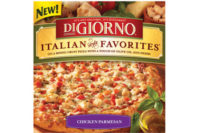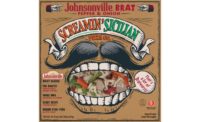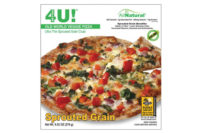Conventional frozen pizza has suffered some setbacks, but the outlook is good for brands that differentiate. The market still carries mass appeal, as consumers seek foods with unique flavors and ingredients. Rising to the top are specialty and artisan varieties offering healthier nutrient profiles and unique flavors.
It’s no secret that Americans love pizza, and any lingering doubts were put to rest when the U.S. Department of Agriculture (USDA) released its “What We Eat in America” report. It turns out that 13% of the population over 2 years of age eats pizza on any given day. The report also confirmed what parents suspected all along: Kids love and eat pizza the most. About 22% of older children ages 6 to 11 years and adolescents ages 12 to 19 years eat pizza on any given day.
But it’s not just kids driving the pizza craze. Andy Shripka, portfolio marketing director at Kashi Co., Battle Creek, Mich., reports that the percentage of one-person households has grown over the last 40 years, from 17% of total households in 1970 to 27% today, amounting to 32 million Americans who live by themselves. As such, a frozen pizza is a great on-the-go (or in-a-pinch) option.
Still, the frozen pizza they’re reaching for now might not be the same product it was a decade ago. “The frozen pizza category in the U.S. is a $4 billion mass-appeal category,” explains Amy Lotker, owner and executive vice president of sales and marketing at Delray Beach, Fla.-based Better For You Foods LLC. “Frozen pizza manufacturing has experienced a yearly decline in growth over the past five years. Yet, over the same five-year span, the frozen, ‘all-natural’ specialty pizza category has seen steady growth, surpassing the regular frozen set by 9.2%.”
Mike Pytlinski, brand director at Palermo’s Pizza, Milwaukee, is also seeing growth at the upper end of the category, as consumers look for that something extra. “In 2013, the middle and lower ends of the category were flat or down, while the top two price segments were up fairly significantly,” he says. “We see this as an extension of other categories, where consumers are willing to pay a premium for higher-end products that are unique and deliver quality.”
Indeed, the frozen pizza category has suffered some setbacks, says Mark Carlson, vice president of operations at Woodridge, Ill.-based Home Run Inn, a fourth-generation, family-owned business. Commodity costs on cheese, pork and beef products, along with a California drought that affected tomato crops, yielded high ingredient prices. “Also, you’re fighting competition with pizzerias, which have gotten much more competitive with their pricing in recent years,” he adds. “I think you’re going to see the total gross dollars of the category go down over the next year or two, but you’ll see the quality rise, and there will be fewer offerings. The ones that do remain will be of better quality.”
When it comes to differentiating in the freezer, there are a number of trends leading the way.
Upping the health ante
Many people consider the frozen pizza category to be an unhealthy one, filled with high-sodium, high-preservative, high-cholesterol, microwavable fare. Manufacturers are changing the conversation by differentiating themselves with healthier ingredient profiles.
“Innovation and changes in consumer demand have contributed to the decline of the overall frozen pizza category that primarily consists of high-fat, high-sodium frozen pizza brands, many launched a decade ago,” says Lotker, adding that consumers today are more ingredient-conscious and demand better ingredients. “Frozen pizza manufacturers are working to meet increased consumer demand for products that adhere to trending dietary choices, such as portion control, allergen-free and enhanced nutritional value.” She predicts that as the overall frozen pizza category declines, the healthy frozen pizza category will only continue to climb.
In February, Better For You Foods launched its newest sprouted grain frozen offering, the Mediterranean Ultra Thin Sprouted Grain Pizza. It’s high in fiber and contains high amounts of whole grain. “Because sprouted grain products have a lower glycemic index, they are recommended for people with diabetes,” Lotker adds.
Grecian Delight Foods Inc., Elk Grove Village, Ill., a manufacturer and marketer of Greek and ethnic foods for foodservice and retail, is also finding that its alternative grain pizza crusts are rising in popularity. “We’ve found an ability to introduce white whole-wheat, whole-wheat and multigrain varieties that taste good and provide the fiber requirements being requested by our customers,” says general manager and executive vice president, Peter Cokinos. “Our whole-grain crusts predominantly target K-12 suppliers, as this segment has a new set of nutritional needs.”
This month, Vitalicious Inc., New York, will launch its new Cheese & Tomato VitaPizza and Meatless Pepperoni Supreme VitaPizza. Each individually-wrapped VitaPizza contains 220 calories, 19 g. of fiber and 15-16 g. of protein.
Amy’s Kitchen, Petaluma, Calif., began shipping Light & Lean Roasted Vegetable No Cheese Pizza last September, along with its Amy’s Single Serve Gluten Free Rice Crust Daiya Cheeze Pizza and Vegan Margherita Pizza. The Light & Lean pizza is topped with caramelized red and yellow onions, fire-roasted red bell peppers, shiitake mushrooms and artichoke hearts. Each portion only has 260 calories.
Clearly clean label
“We are seeing a trend in clean-label ingredients as consumers look for more transparency in their food,” explains Tom Dixon, vice president of pizza marketing at Schwan’s Consumer Brands Inc., Marshall, Minn. To that end, the company’s Freschetta pizzas feature 100% all-natural cheeses, sauces made from ripe tomatoes, vegetables flash-frozen at their peak of freshness and fresh meats like special-recipe pepperoni, seasoned sausage and lean Canadian-style bacon.
“In addition, all our Naturally Rising and Brick Oven pizzas feature a preservative-free crust,” he adds. Freschetta updated its packaging in 2013 to reflect this better-for-you trend, adding an image on each box representing the ingredients that make up that variety of pizza.
The gluten-free factor
For many people, a clean label doesn’t just mean clean of preservatives or calories. It also means clean of allergens, specifically, gluten. “Our primary consumer is living a gluten-free or low-gluten lifestyle—whether it is due to celiac disease, gluten sensitivities or just choosing gluten-free products to feel better,” says Denise Sirovatka, vice president of marketing at Udi’s Gluten Free, Boulder, Colo.
According to Sirovatka, this traditionally underserved group has learned to recreate their favorite meals at home and, as a result, has high expectations for any products it chooses to purchase. “Because the price point of gluten-free foods can be higher than conventional foods, their decision-making process is more intensive,” she explains. “We can’t offer a mediocre product to these consumers; they are expecting higher quality ingredients, unique flavor profiles and foods that are ‘missing’ from their diet.”
Udi’s offers gluten-free pizza crusts along with Three Cheese Pizza; Margherita Pizza; Pepperoni Pizza; and Spinach & Feta Pizza. And since so many gluten-free shoppers are also health-conscious, Udi’s highlights premium ingredients like uncured pepperoni right on the label. “We also leverage genetically modified organisms (GMOs) ingredients, when appropriate, and promote protein and calcium claims,” Sirovatka adds.
Better For You Foods is also targeting gluten-free consumers with a new line of 7" Personal Size Gluten Free Pizzas. The pizzas are free of GMOs, contain Omega 3 and Omega 6 fatty acids, and are low in sodium, calories and fat. “The personal size versions of our multi-serve pizzas are well-received by people who appreciate the portion control and the lower price point associated with the smaller product,” says Lotker.
Schwan’s Consumer Brands introduced a Gluten Free 4 Cheese Pizza and Signature Pepperoni Pizza into its lineup in February, which features a 100% real premium cheese blend that includes mozzarella, fontina, parmesan and Asiago.
Finding success with specialty
Beyond labels’ added nutrition and subtracted allergens, specialty varieties are allowing pizza brands to set themselves apart from competitors. “Specialty is no longer on a small scale,” says Don Czerwonka, vice president of sales at Little Lady Foods, Elk Grove Village, Ill. “It includes categories like gourmet/artisan, organic, all-natural, creative, nutritional and culturally inspired.”
Shripka agrees: “Now, more than ever, consumers seek foods with unique flavors and ingredients, and pizza is certainly no exception. We have seen significant demand for upscale, artisan-style pizzas with unique and progressive ingredients that aren’t just nutritious, but also great-tasting.”
Kashi’s new single-serve pizzas, launched in December, start with a traditional-style, stone-fired crust made with Kashi Seven Whole Grains, flax and sesame. The Greek Tzatziki variety is topped with spinach, artichokes, tomatoes, feta, mozzarella and a Greek Tzatziki yogurt, cucumber, dill and garlic sauce. It has 6 g. fiber, 17 g. protein and 23 g. whole grains. Kashi’s Indian Tikka Masala variety is topped with mozzarella, fire-roasted eggplant, spinach, tomatoes, crushed red pepper and a spicy Tikka Masala sauce. It boasts 7 g. fiber, 18 g. protein and 24 g. whole grains.
Last August, Palermo’s Pizza introduced Screamin’ Sicilian, a craft pizza featuring an artisan, hearth-baked crust and locally sourced ingredients like slices of fresh mozzarella, sausage, fire-roasted vegetables and tomato sauce made from ground tomatoes. It comes in Bessie’s Revenge (cheese); Boss Hog (Italian sausage); Holy Pepperoni (pepperoni); Supremus Maximus (supreme); Mambo Italiano (Italian combo); and Slicy Clucker (jalapeno chicken, bacon ranch sauce and cheese) varieties.
“I am optimistic that the frozen pizza category will continue to grow in years ahead,” says Dixon. “Yes, we’ve hit a bump or two in the past, but we are steadily bridging the gap from previous years as we continue to focus on quality ingredients and great tasting pizzas. We see endless possibilities for the pizza category. With new flavors, sizes and dietary-specific varieties coming out, we are excited about what the future holds.”











